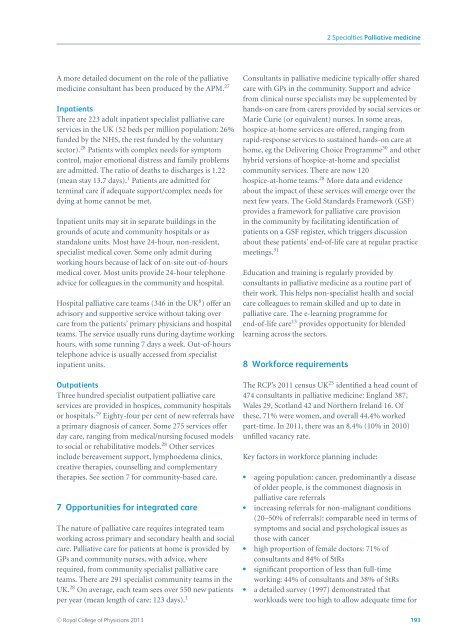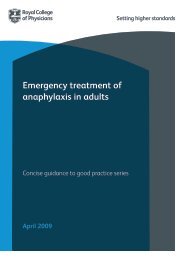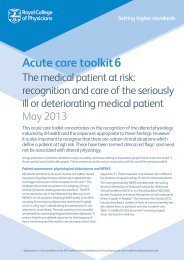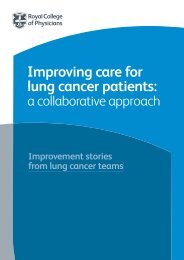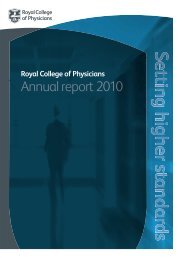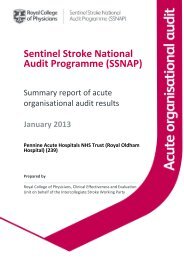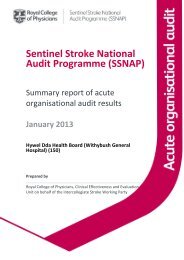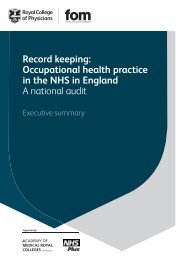Consultant physicians working with patients - Royal College of ...
Consultant physicians working with patients - Royal College of ...
Consultant physicians working with patients - Royal College of ...
You also want an ePaper? Increase the reach of your titles
YUMPU automatically turns print PDFs into web optimized ePapers that Google loves.
2 Specialties Palliative medicineA more detailed document on the role <strong>of</strong> the palliativemedicine consultant has been produced by the APM. 27In<strong>patients</strong>There are 223 adult inpatient specialist palliative careservices in the UK (52 beds per million population: 26%funded by the NHS, the rest funded by the voluntarysector). 28 Patients <strong>with</strong> complex needs for symptomcontrol, major emotional distress and family problemsare admitted. The ratio <strong>of</strong> deaths to discharges is 1.22(mean stay 13.7 days). 1 Patients are admitted forterminal care if adequate support/complex needs fordyingathomecannotbemet.Inpatient units may sit in separate buildings in thegrounds <strong>of</strong> acute and community hospitals or asstandalone units. Most have 24-hour, non-resident,specialist medical cover. Some only admit during<strong>working</strong> hours because <strong>of</strong> lack <strong>of</strong> on-site out-<strong>of</strong>-hoursmedical cover. Most units provide 24-hour telephoneadvice for colleagues in the community and hospital.Hospital palliative care teams (346 in the UK 8 )<strong>of</strong>feranadvisory and supportive service <strong>with</strong>out taking overcare from the <strong>patients</strong>’ primary <strong>physicians</strong> and hospitalteams. The service usually runs during daytime <strong>working</strong>hours, <strong>with</strong> some running 7 days a week. Out-<strong>of</strong>-hourstelephone advice is usually accessed from specialistinpatient units.Out<strong>patients</strong>Three hundred specialist outpatient palliative careservices are provided in hospices, community hospitalsor hospitals. 29 Eighty-four per cent <strong>of</strong> new referrals havea primary diagnosis <strong>of</strong> cancer. Some 275 services <strong>of</strong>ferday care, ranging from medical/nursing focused modelsto social or rehabilitative models. 28 Other servicesinclude bereavement support, lymphoedema clinics,creative therapies, counselling and complementarytherapies. See section 7 for community-based care.7 Opportunities for integrated careThe nature <strong>of</strong> palliative care requires integrated team<strong>working</strong> across primary and secondary health and socialcare. Palliative care for <strong>patients</strong> at home is provided byGPs and community nurses, <strong>with</strong> advice, whererequired, from community specialist palliative careteams. There are 291 specialist community teams in theUK. 28 On average, each team sees over 550 new <strong>patients</strong>per year (mean length <strong>of</strong> care: 123 days). 1<strong>Consultant</strong>s in palliative medicine typically <strong>of</strong>fer sharedcare <strong>with</strong> GPs in the community. Support and advicefrom clinical nurse specialists may be supplemented byhands-on care from carers provided by social services orMarie Curie (or equivalent) nurses. In some areas,hospice-at-home services are <strong>of</strong>fered, ranging fromrapid-response services to sustained hands-on care athome, eg the Delivering Choice Programme 30 and otherhybrid versions <strong>of</strong> hospice-at-home and specialistcommunity services. There are now 120hospice-at-home teams. 28 More data and evidenceabout the impact <strong>of</strong> these services will emerge over thenext few years. The Gold Standards Framework (GSF)provides a framework for palliative care provisionin the community by facilitating identification <strong>of</strong><strong>patients</strong> on a GSF register, which triggers discussionabout these <strong>patients</strong>’ end-<strong>of</strong>-life care at regular practicemeetings. 31Education and training is regularly provided byconsultants in palliative medicine as a routine part <strong>of</strong>their work. This helps non-specialist health and socialcare colleagues to remain skilled and up to date inpalliative care. The e-learning programme forend-<strong>of</strong>-life care 13 provides opportunity for blendedlearning across the sectors.8 Workforce requirementsThe RCP’s 2011 census UK 25 identified a head count <strong>of</strong>474 consultants in palliative medicine: England 387,Wales 29, Scotland 42 and Northern Ireland 16. Ofthese, 71% were women, and overall 44.4% workedpart-time. In 2011, there was an 8.4% (10% in 2010)unfilled vacancy rate.Key factors in workforce planning include: ageing population: cancer, predominantly a disease<strong>of</strong> older people, is the commonest diagnosis inpalliative care referrals increasing referrals for non-malignant conditions(20–50% <strong>of</strong> referrals): comparable need in terms <strong>of</strong>symptoms and social and psychological issues asthose <strong>with</strong> cancer high proportion <strong>of</strong> female doctors: 71% <strong>of</strong>consultants and 84% <strong>of</strong> StRs significant proportion <strong>of</strong> less than full-time<strong>working</strong>: 44% <strong>of</strong> consultants and 38% <strong>of</strong> StRs a detailed survey (1997) demonstrated thatworkloads were too high to allow adequate time forC○ <strong>Royal</strong> <strong>College</strong> <strong>of</strong> Physicians 2013 193


